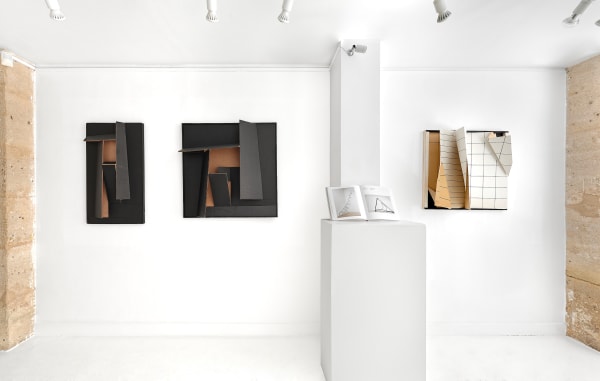Grazia Varisco: Perceptives Experiences
Past exhibition
Installation Views
Overview
Following Grazia Varisco’s participation in the 59th Venice Biennale (the international exhibition The Milk of Dreams curated by Cecilia Alemani) and her prestigious retrospective at the Palazzo Reale in Milan, Espace Meyer Zafra is pleased to announce Varisco’s first personal exhibition in France, Perceptive Experiences. From May 24 to July 31, 2023, the exhibition will present emblematic works by the artist from the 1960s to the 2000s.
“Alongside her fascination with the industrial aesthetic and with emerging computer technology, Varisco immediately focused on the relationship that a work establishes with the viewer, trying to foster engagement through kinetic stimuli.” - Stefano Mudu, “Grazia Varisco, Technologies of Enchantment, The Milk of Dreams”, curated by Cecelia Alemani, La Biennale di Venezia, Venice, 2022
Grazio Varisco, a major figure in kinetic and programmed art, was one of the first artists to explore kinetic concepts such as movement and the evolution of change and to interplay these concepts directly with her audience. Her works inhabit the space around them using simple elements and to create different spatial dimensions challenging the viewer’s perception and disorienting the senses.
The exhibition Perceptive Experiences explores the experiments the artist designed intentionally to disturb the viewer’s senses. Perception consists of a complex psychological organization by which the mind interprets the representation of the object in question by processing visual and sensory data. In evoking the work Gnom-one- two-three (presented at Paris + Art Basel in the Jardin des Tuileries in October 2022), Grazia Varisco perfectly describes the central theme of this exhibition: “A work like Gnom-one-twothree is for me the occasion of an unusual experience of physical space, mental space, of its existence, of its possible expansion, of its availability to my breath and my gaze, of its welcome to my movement. “.
In 1960 Grazia Varisco and her colleagues from the Academia di Brera joined Gruppo T to collaborate with Giovanni Anceschi, Gianni Colombo, Davide Boriani and Gabriele de Vecchi. (T represented the introduction of time as a new variable in art.) When founded in Milan in 1959, Gruppo T had become one of the most important kinetic art groups by introducing innovative art forms through the creation of perceptual experiences and interactive environments that were designed to generate unexpected reactions in the spectator. By the end of the 1950s Grazia Varisco had been using industrial materials and increasingly had inserted the concept of time into the center of her work (as evidenced by her first kinetic work Tavole Magnetiche presented at the exhibition Miriorama 6 made by Gruppo T in February 1960). The Schemi Luminosi and Reticoli frangibili series presented during this exhibition are is a perfect example of Varisco’s fit with Gruppo T. The works of this first series (exhibited at the Venice Biennale in 1964, 1986 and 2022) are luminous moving forms activated by a motor creating optical illusions, sensory disturbances. The works of the second series are simple traces of colors figured in the background of the work. The optical effect here is caused by the undulations of this glass so characteristic of the 60s and 70s. As the spectator moves, the initially fixed pattern disappears, re-forms or transforms in an unpredictable way, causing a strong feeling of disorientation.
Throughout her career, Grazia Varisco carries out a continuous stripping in her works. The void becomes an essential element for the understanding, or rather the disturbance of the viewer. The Italian art critic Claudio Cerritelli describes this: “Between 1975 and 1987, Grazia Varisco captured in the project of a three-dimensional geometry that indeterminate void that takes shape in the trap of the wall, between elements leaning on it and others projecting from it, magnetizing the surrounding energies. From inside the room the elements also inhabit the exterior, in a virtual idea of sculpture that dilates as far as possible the physical and mental breadth of the environment, with great angular tension towards all the dimensions of the landscape. [...] Even the impalpable dimension of the shadow becomes a precise instrument for writing space, a sort of evocation of virtual forms that originate from the folding of materials, from their angles, from the flatness or the swelling of their apparent reality. “. The fold that Grazia Varisco will use throughout her career will serve as her tool for creating spaces, full or empty (ex: Extralibro, 1975; Quadrangoli, 1990; Oh! All’angolo, 1997) and as a tool creation of virtual forms (ex: Implicazioni B/N, 1986; Meridiana, 1974; Gnomoni, 1985).
The notions of perception and void that have crossed Varisco’s work throughout her career are illustrated metaphorically and visually by the work Fillo Rosso, or Fil Rouge in French (Fil rouge definition: ‘a red thread’; a recurrent guiding idea that ensures the coherence of the whole by becoming a point of reference).
To use Cecilia Alemani’s title for the section in which Grazia Varisco’s work starred at the 59th Venice Biennale, the exhibition Perceptive Experiences will enchant its viewers. See and be bewitched.







